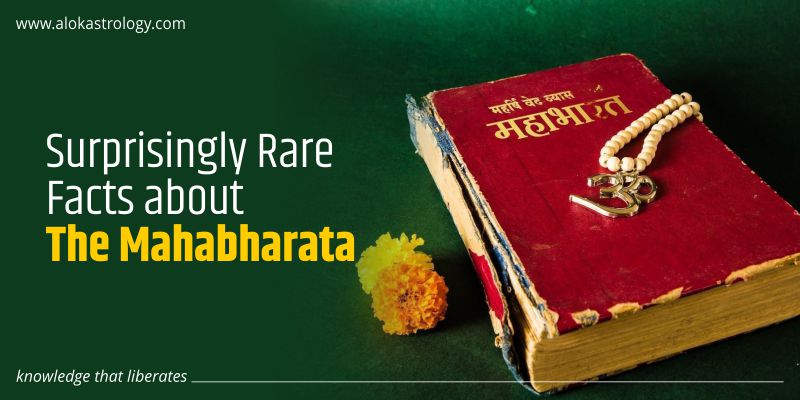Every incident from the illustrious Mahabharata is well known to us all. Ramayana and Mahabharata are sacred books of Hinduism covering two major events. Ramayana is the first poem written by humans, whereas Mahabharata is the longest poem ever composed.
Mahabharata describes the Kauravas-Pandavas war for Hastinapur. The war is commonly known as the Battle of Kurukshetra. The vast epic of the Mahabharata includes the Bhagavad Gita, one of the most significant and revered literature.
The Mahabharata is now well-known thanks to several compilation books, TV shows, and motion pictures. This generation is therefore familiar with all of the Mahabharata’s historical events. There are, however, a few lesser-known details regarding the Mahabharata, including;
Get an online astrology consultation by the world-renowned Astrologer Mr. Alok Khandelwal.
- The original name for the Mahabharata was Jaya, Jayam, Vijaya, and Bharata.
Legends say Veda Vyasa wrote Mahabharata. Others say Lord Ganesh recorded Veda Vyasa’s statements. The book was known as Jaya or Jayam, meaning spiritual success.
Vijaya means “success in the eyes of the world,” therefore when sage Vaisampayana (who taught Krishna the Yajur-Veda) told this narrative to King Janamejaya, he gave it that name. Vijaya became Bharata, and the name Mahabharata was created after incorporating stories and incidents. - Veda Vyasa wasn’t a name; it was more of a position.
It is common knowledge that Sage Veda Vyasa narrated to Lord Ganesha the story of the Mahabharata. However, Veda Vyasa was a title awarded to every sage who had amassed knowledge of all four Vedas; the sage’s actual name was Krishna Dvaipayana. Vyasa means compiler in Sanskrit. - Lord Yama was reborn in the form of Vidura.
Lord Yama was cursed as a maid’s son by the sage Mandavya for torturing him without cause. Lord Yamraj was a Vidura (maid’s son). He embodied righteousness, honesty, duty, and wisdom as kuru’s prime minister. - Abhimanyu was the reincarnation of an asura.
Lord Krishna called Abhimanyu Kalayavana, a formidable asura. Lord Shiva protected him against Yadavas. As a Yadava, he might kill Krishna. Kalayavana lacks information on Chakravyuha or Padmavyuha. Lord Krishna instructed Abhimanyu on how to enter the Chakravyuha but not how to leave. Lord Krishna planned to assassinate Kalayavana as Abhimanyu.
- A Brahman’s curse caused Karna’s death.
Karna once practiced the Shabd Bedi arrow, which uses sound or words to hit its target. He accidentally shot a Brahmin’s cow for a wild animal. This Brahmin cursed Karna to die while distracted. Lord Krishna told Arjuna to slay Karna when pulling his chariot from the mud.
- Pandavas could be killed by five magical arrows.
One of the strongest and greatest fighters in the battle of Kurukshetra was Bhishma Pitamaha. He was armed with five golden arrows, each of which could put an end to the conflict by killing the Pandavas.
- Duryodhana once said that Bhishma wasn’t fighting from the heart.
Bhishma was furious at Duryodhan’s charge and grabbed his five golden arrows. Duryodhana thought Bhishma wouldn’t utilize it. He took five arrows. Krishna knew about the arrows. Lord Krishna told Arjun to approach Duryodhana, reminding him of his pledge. Arjuna requested Duryodhana for the 5 arrows he’d promised. Duryodhana was obligated to deliver Arjuna the winning arrows.
- Bhishma knew who Shikandi was
Shikandi was an androgynous female with masculine traits. Shikandi was supposedly Devi Amba’s reincarnation. She was given the blessing by Lord Shiva to be the reason Bhishma died. Bhishma shared this secret with the Pandavas about how they would beat him in the battle. - At first, it was planned for Subhadra to marry Duryodhana.
It was Balarama’s intention to wed his sister to Duryodhana, Subhadra’s brother. But Subhadra liked Arjuna. She decided to marry Arjuna and went away with him.
- Greatest Chariot of Lord Krishna
Arjuna’s charioteer in the Kurukshetra conflict was Krishna. During the 18-day combat, various celestial weapons hit the divine chariot. Lord Krishna depowers these weapons so they don’t harm the chariot until their mission is met. Lord Krishna instructed Arjuna to exit the chariot first after the Mahabharata. Arjuna’s chariot exploded as he descended; - There were four wives for Arjuna.
Along with Draupadi, Arjuna also had three other wives: Subhadra, the sister of Krishna, Chitrangadha, the princess of Manipur, and Ulupi, the princess of the Nagas. - Dhristadyumna is the reincarnation of Eklavya.
Eklavya’s father was Vasudeva’s (Krishna’s father) brother. In Rukmini Haran, Krishna murdered him. Later, he took the form of Draupadi’s son to exact revenge on Guru Dronacharya for all the wrongs he had committed against Eklavya in his previous existence. - Arjuna once spared Duryodhana’s life.
Duryodhana humiliated the Pandavas and their slaves in Dwaita woodland. He came upon Gandharva King Chitrasena taking a bath with apsaras as he was traveling. Duryodhana fought Chitrasena because of desire. Duryodhana was defeated by Chitrasena, who then imprisoned him as a slave. Arjuna went to the lake to ask Chitrasena to free Duryodhana. Chitrasena freed Duryodhana at Arjuna’s request. Duryodhana promises Arjuna a boon to ask him anything at any moment.
